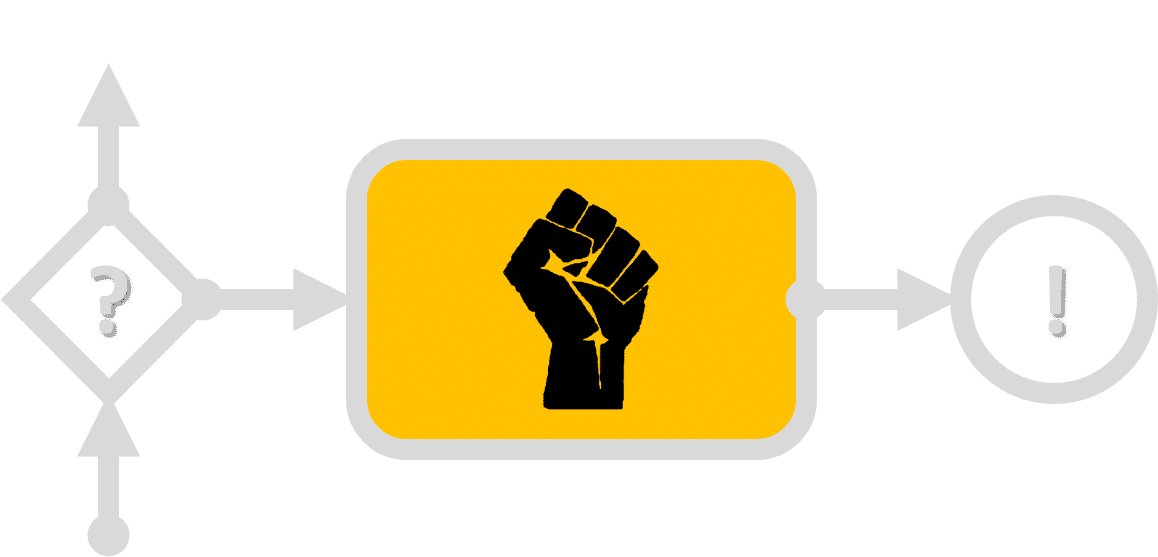(The TaskTrain Manifesto)

At TaskTrain, we’re dedicated to enabling everyone to achieve excellence … every time.
Our foundational beliefs follow.
Process Predicts Product
Sometimes you get lucky. Sometimes you flub things up along the way and still make the mark. On the other hand, sometimes you dot every i and cross every t and still get a lousy outcome due to circumstances beyond your control. These are the two tails of the normal distribution of probabilities. Usually, though, what you do and how you do it reliably determine what you get. Follow a proven process, get a predictable result. Do so reliably and, all else being equal, you’ll inevitably excel.
But that’s not to say that either finding or following a good process is always easily. In today’s complex and dynamic work environment, determining and then remembering what to do when and in what order to get what you want is no small task. Human memory and attention are limited. Routine mistakes accumulate to enormous waste and tiny errors too often trigger costly consequences.
We believe that getting things right isn’t always easy, but it’s essential.
Excellence Is For Everyone
Consistent quality is often associated with big companies: Coca Cola. Apple. BMW. Such well-known brands have the resources to invest in developing and delivering tightly controlled production and service processes that produce consistent results. In the era of mass production, scale and consistency triumphed over the variability of small “mom and pop” shops.
But information technology levels the playing field by democratizing access to the tools that enable excellent outcomes.
We believe that good process and consistent results should not be the sole province of big companies that can afford quality management departments and Six Sigma Black Belts.
Waste Nothing, Including Opportunities
Waste is wicked. It impoverishes the world by squandering resources without contributing value. Waste comes in many forms: Resources consumed in producing defective parts due to manufacturing mistakes. Rework resulting from errors or inefficient, inconsistent work processes. Procedures written but neglected. Training delivered but forgotten. Skills developed but not utilized.
But missed opportunities are also a waste, so waste reduction must focus on eliminating errors, not capability. Appropriate redundancy, slack, and spare capacity are essential to seizing new opportunities and creating organizations that are resilient, not fragile, responsive, not rigid.
We believe that waste reduction expands capacity.
Eradicate Errors, Embrace Failure
If the outcome and path are known, then “Process Predicts Product” implies that achieving quality and minimizing waste means avoiding mistakes and doing things right every time.
But innovation requires trying new things, not all of which will work, and so it’s important to drive out the fear failure when the objective is not to do what’s been done well before but to create something new and better, and creating something new and better is the foundation of all progress.
We believe that failure is fine; mistakes are not.
Accountability, Not Authoritarianism
When “Process Predicts Product,” controlling process becomes central to success.
But micromanaging people is a surefire recipe for resentment, killing commitment and innovation.
We believe that when goals are shared and decision-making appropriately distributed, systems can be flexible enough to ensure accountability without being authoritarian.
Efficiency Is Not Effectiveness
Efficiency is all about doing things right. Achieving the biggest outcome with the least effort. Being as productive as possible.
But if the goal pursued is ultimately counterproductive, achieving it efficiently may be worse than the alternative.
We believe that doing the right things comes before doing things right.
Keep It Simple, (Not) Stupid
Process is only as good as its implementation. The best procedure will do you no good in producing desired results if it’s too complex for anyone to follow.
But simplification can be taken too far. A Zen-like minimalist user interface without affordances to inform the user how to interact with it intuitively may be aesthetically appealing, but wastes time and causes frustration. Such design is simplistic, not simple.
We believe Albert Einstein’s wisdom that “Everything should be made as simple as possible, but not simpler.”
So that’s the idea (subject to continuous improvement).
Process to the People!
Recent Posts
How Small Businesses Can Use Business Process Management Software?
Introduction Imagine a tool that transforms chaos into order, a magic wand for your small business's processes. That's Business Process [...]
Continuity of Operations: Business Continuity Planning for Small and Medium Businesses
Continuity of Operations Planning (COOP) stands as a strategic endeavor in organizational settings, aimed at guaranteeing the seamless execution of [...]
Common Mistakes to Avoid When Developing Standard Operating Procedures
Introduction Standard Operating Procedures (SOPs) are internal company documents that outline instructions for employees to carry out various tasks [...]




 .
.